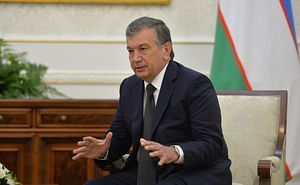Accountability of government officials and economic sustainability have been two major goals put forward to local governments by Uzbekistan’s new leadership. Hokims (regional governors) are at the helm of the reform process at the regional level, but because many are ill-fitted to President Shavkat Mirziyoyev’s entrepreneurial spirit and ideals, this misalignment of management style has been reflected in the regular sacking, removing, and shuffling of hokims.
Hokims have historically been appointed by the president to serve for five years. Sitting atop the regional power structure, they constitute the highest authority in their regions. There are 12 regions in Uzbekistan, plus Tashkent city and the Autonomous Republic of Karakalpakstan. The 12 regions and Tashkent city are governed by hokims (viloyat hokimi and Toshkent shahar hokimi). Each region and the Autonomous Republic of Karakalpakstan is divided into districts and cities (from 10 to 20) that are governed by district and city hokims (tuman and shahar hokimi). The Constitution of Uzbekistan bestows a wide range of responsibilities on hokims, ranging from safety and security of the population to oversight of economic, social, cultural, fiscal, utility, and environmental matters.
Because there are many more district and city hokims, their shuffling and dismissals have been taking place more frequently compared to regional hokims. For example, under Mirziyoyev, Karakalpakstan Republic replaced 14 of 15 hokims as of February 2018. The reasons for dismissal are usually ambiguous and generalized as lack of accountability to the population they serve. The real reasons could be the new leadership’s contempt for the “old way” of working – a euphemism for the working culture widely practiced under the previous regime. In one recent instance, the district hokim in Syrdarya, Nosirjon Egamberdiev, was sacked for slapping his district school principals.
The shuffling and dismissal of regional hokims do not happen with the same frequency and are usually triggered by serious allegations. The most scandalous dismissal took place in July 2018 when Samarkand region’s hokim, Turobjon Juraev, was sacked on the allegation of building a ”vertical corruption scheme” in government issued building permits.
It seems that the outright dismissal of regional hokims has tended to happen with more caution, perhaps to avoid agitating a disgraced official and disturbing loyalties and kinship ties hokims built during their tenure. Therefore, unless the central government is comfortable enough to act against an official, most hokims stay in the system, like former Tashkent region hokim Shukurllo Boboev and former Jizzah region hokim Ulugbek Uzoqov, both demoted to district hokims in Jizzakh region in April 2018.
The new leadership is not on an all-out offensive against local governments. Mirziyoyev has clearly offered his backing to hokims and is attempting to elevate their status. In his now-famous four-hour address to the Oliy Majlis (parliament) at the end of 2017, he made clear that “a hokim is the representative of a president” and that “any actions against hokims without a due process, including their imprisonment, will trigger equal punishment.” Mirziyoyev later scratched the surface of what he had referred to in his address when he described the anarchy in local governments created by the National Security Service (renamed the State Security Service in early 2018), which de facto ran a region by slandering, threatening, and imprisoning hokims.
The existing tensions between Mirziyoyev and hokims, as well as hokims and the population, are partially due to the fact that a majority of officials are holdovers from the previous administration. Mirziyoyev is mainly recycling officials, rotating and giving them second, third, and further chances. A way out of this cycle was proposed by Mirziyoyev himself: The institution of elections for regional hokims. But judging from the lack of progress on this front, the current administration is not ready to overhaul the direct-appointment system yet.
Mirziyoyev’s government is fighting battles on two fronts. In one, Mirziyoyev is the defender of hokims, elevating their roles and guaranteeing immunity in exchange for serving their population (and his reform program) and moving their economies toward sustainability. In the other, he is the opponent of hokims, battling them, plucking and tossing and planting them back into the system where he desires and demanding that they live up to his expectations. It is worth following these battles closely as the outcomes will inform the future of local government in Uzbekistan.

































